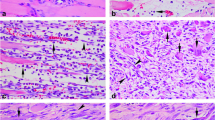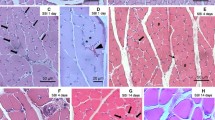Abstract
To estimate the age of skeletal muscle contusion, the expression of troponin I mRNA in contused skeletal muscle of rats was detected using real-time polymerase chain reaction (PCR). A total of 51 Sprague–Dawley male rats were divided into control and contusion groups, and another nine rats received contusion injury after death. At 0.5, 1, 6, 12, 18, 24, 30, and 36 h after contusion, the rats were killed with a lethal dose of pentobarbital. Total RNA was isolated from muscle specimens using the SV Total RNA Isolation System and reverse transcribed into first-strand cDNA. Sequence-specific primers were then used to conduct real-time PCR to analyze the expression levels of sTnI mRNA. At 0.5, 1, and 6 h after contusion, the expression levels of sTnI mRNA decreased to 78.17% (P < 0.05), 41.58% (P < 0.05), and 32.13% of that in the control group, respectively. However, there were no significant changes in the expression levels of sTnI mRNA from 6 to 36 h (P > 0.05) after contusion when normalized to RpL32 expression. The expression levels of sTnI mRNA in the normal and contused skeletal muscle of postmortem rats were about 70% of that in the control group (P < 0.05), and no significant changes in the expression levels of sTnI mRNA in the postmortem contusion group were noted among different time points after injury. This result suggests that determination of sTnI mRNA levels by real-time PCR is useful for the estimation of wound age.







Similar content being viewed by others
References
Takamiya M, Saigusa K, Kumagai R, Nakayashiki N, Aoki Y (2005) Studies on mRNA expression of tissue-type plasminogen activator in bruises for wound age estimation. Int J Leg Med 119:16–21
Stephenson T, Bialas Y (1996) Estimation of the age of bruising. Arch Dis Child 74:53–55
Sato Y, Ohshima T (2000) The expression of mRNA of proinflammatory cytokines during skin wound healing in mice: a preliminary study for forensic wound age estimation (II). Int J Leg Med 113:140–145
Kondo T, Ohshima T, Eisenmenger W (1999) Immunohistochemical and morphometrical study on the temporal expression of interleukin-1alpha (IL-1alpha) in human skin wounds for forensic wound age determination. Int J Leg Med 112:249–252
Zhang H, Zhu SH, Qin QS (2004) Immunohistochemical and morphometrical study on the expression of interleukin-10 (IL-10) in different expressive parts during cutaneous wound healing in mice(in Chinese). J Forensic Med 20:70–72
Kondo T, Ohshima T, Mori R, Guan DW, Ohshima K, Eisenmenger W (2002) Immunohistochemical detection of chemokines in human skin wounds and its application to wound age determination. Int J Leg Med 116:87–91
Dressler J, Bachmann L, Strejc P, Koch R, Muller E (2000) Expression of adhesion molecules in skin wounds: diagnostic value in legal medicine. Forensic Sci Int 113:173–176
Dressler J, Bachmann L, Koch R, Muller E (1999) Estimation of wound age and VCAM-1 in human skin. Int J Leg Med 112:159–162
Sisco M, Liu WR, Kryger ZB, Mustoe TA (2007) Reduced up-regulation of cytoprotective genes in rat cutaneous tissue during the second cycle of ischemia-reperfusion. Wound Repair Regen 15:203–212
Iino M, Nakatome M, Ogura Y et al (2003) Real-time PCR quantitation of FE65 a beta-amyloid precursor protein–binding protein after traumatic brain injury in rats. Int J Leg Med 117:153–159
McBrier NM, Lekan JM, Druhan LJ, Devor ST, Merrick MA (2007) Therapeutic ultrasound decreases mechano-growth factor messenger ribonucleic acid expression after muscle contusion injury. Arch Phys Med Rehabil 88:936–940
Sodowich BI, Fadl I, Burns C (2007) Method validation of in vitro RNA transcript analysis on the Agilent 2100 Bioanalyzer. Electrophoresis 28:2368–2378
Carrol ED, Salway F, Pepper SD et al (2007) Successful downstream application of the Paxgene Blood RNA system from small blood samples in paediatric patients for quantitative PCR analysis. BMC Immunol 8:20
Ortiz-Rey JA, Suarez-Penaranda JM, Munoz-Barus JI, Alvarez C, San Miguel P, Rodriguez-Calvo MS, Concheiro-Carro L (2003) Expression of fibronectin and tenascin as a demonstration of vital reaction in rat skin and muscle. Int J Leg Med 117:356–360
Grellner W, Georg T, Wilske J (2000) Quantitative analysis of proinflammatory cytokines (IL-1beta, IL-6, TNF-alpha) in human skin wounds. Forensic Sci Int 113:251–264
Hausmann R, Nerlich A, Betz P (1998) The time-related expression of p53 protein in human skin wounds—a quantitative immunohistochemical analysis. Int J Leg Med 111:169–172
Dressler J, Bachmann L, Kasper M, Hauck JG, Muller E (1997) Time dependence of the expression of ICAM-1 (CD 54) in human skin wounds. Int J Leg Med 110:299–304
Ortmann C, Pfeiffer H, Brinkmann B (2000) A comparative study on the immunohistochemical detection of early myocardial damage. Int J Leg Med 113:215–220
Hayashi T, Ishida Y, Kimura A, Takayasu T, Eisenmenger W, Kondo T (2004) Forensic application of VEGF expression to skin wound age determination. Int J Leg Med 118:320–325
Bai R, Wan L, Shi M (2008) The time-dependent expressions of IL-1beta, COX-2, MCP-1 mRNA in skin wounds of rabbits. Forensic Sci Int 175:193–197
Anderson S, Howard B, Hobbs GR, Bishop CP (2005) A method for determining the age of a bloodstain. Forensic Sci Int 148:37–45
Zubakov D, Hanekamp E, Kokshoorn M, van Ijcken W, Kayser M (2008) Stable RNA markers for identification of blood and saliva stains revealed from whole genome expression analysis of time-wise degraded samples. Int J Leg Med 122:135–142
Karlsson H, Guthenberg C, von Dobeln U, Kristenssson K (2003) Extraction of RNA from dried blood on filter papers after long-term storage. Clin Chem 49:979–981
Ohshima T, Sato Y (1998) Time-dependent expression of interleukin-10 (IL-10) mRNA during the early phase of skin wound healing as a possible indicator of wound vitality. Int J Leg Med 111:251–255
Onuoha GN, Alpar EK, Dean B, Tidman J, Rama D, Laprade M, Pau B (2001) Skeletal troponin-I release in orthopedic and soft tissue injuries. J Orthop Sci 6:11–15
Simpson JA, Labugger R, Collier C, Brison RJ, Iscoe S, Van Eyk JE (2005) Fast and slow skeletal troponin I in serum from patients with various skeletal muscle disorders: a pilot study. Clin Chem 51:966–972
Shimada I, Matsui K, Brinkmann B et al (2008) Novel transcript profiling of diffuse alveolar damage induced by hyperoxia exposure in mice: normalization by glyceraldehyde 3-phosphate dehydrogenase. Int J Leg Med 122:373–383
Meyer S, Temme C, Wahle E (2004) Messenger RNA turnover in eukaryotes: pathways and enzymes. Crit Rev Biochem Mol Biol 39:197–216
Acknowledgments
This study was financially supported by the Natural Science Foundation for Young Scientists of Shanxi Province, China (grant no. 2007021047).
Author information
Authors and Affiliations
Corresponding author
Rights and permissions
About this article
Cite this article
Sun, Jh., Wang, Yy., Zhang, L. et al. Time-dependent expression of skeletal muscle troponin I mRNA in the contused skeletal muscle of rats: a possible marker for wound age estimation. Int J Legal Med 124, 27–33 (2010). https://doi.org/10.1007/s00414-009-0323-1
Received:
Accepted:
Published:
Issue Date:
DOI: https://doi.org/10.1007/s00414-009-0323-1




